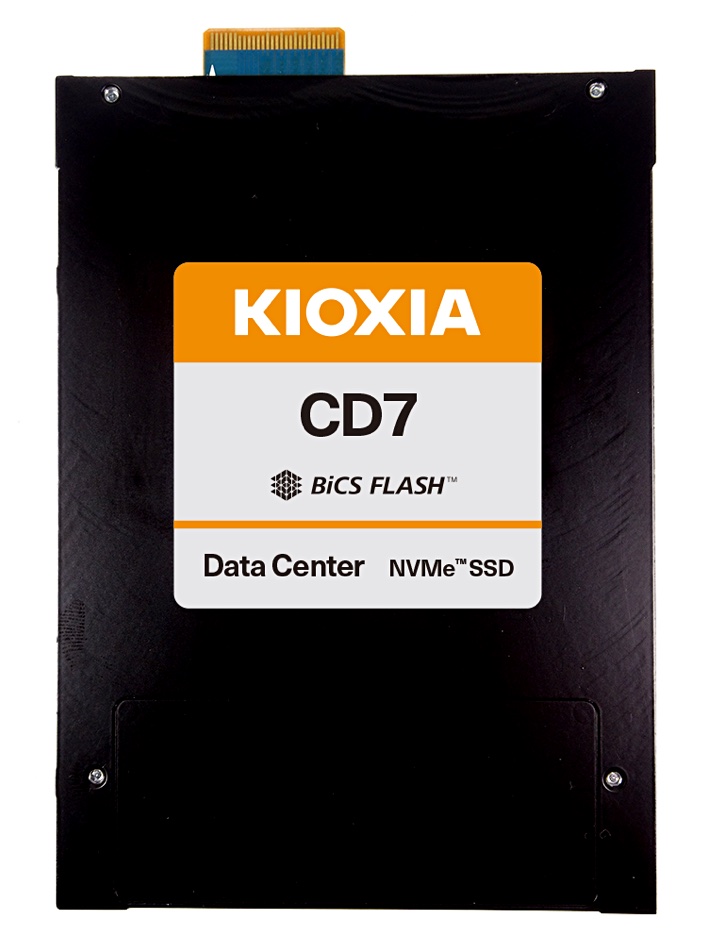Kioxia has announced EDSFF format fifth-generation PCIe SSD product, focussing on holding PCIe 4 speed but cutting the lane count in two.
PCIe 5 operates at 32Gbit/sec lane bandwidth — four times faster than PCIe 3’s 8Gbit/sec and double PCIe 4’s 16Gbit/s sec. The EDSFF (Enterprise and Datacentre SSD Form Factor) leaves the disk drive-based M.2 (gumstick) and U.2 (2.5-inch enclosure) form factors behind, with a set of so-called “ruler” form factors. There are several types, such as the E3 , E1.L and E1.S (Long and Short) form factors, with the E1.S replacing the M.2 form factor, and E.3 set to supersede the U.2 spec.
Kioxia’s announcement quoted Greg Wong, founder and principal analyst at Forward Insights, saying: “The EDSFF E3 form factor is set to redefine the way enterprise servers and storage are designed. We expect the market to transition to EDSFF starting in 2022, with the introduction of PCIe 5.0 based systems.”
That means the ruler format drive introduction has to be choreographed with server and storage array products designed to use the drives. Kioxia, along with Dell and HPE, has made an E3 SSD format white paper available for download, which emphasises the co-operation with server suppliers.
The Kioxia announcement has been timed to appear just before the Open Compute Global Summit, November 9–10.
CD7
Neville Ichhaporia, VP for SSD marketing and product management at Kioxia America, said in a statement: “We see EDSFF as the enterprise NVMe SSD form factor of the future. The E3 versions, optimised for the next generation of enterprise platforms, are well suited to keep technological pace with the incremental demands data-intensive applications are placing on servers and storage.”

Kioxia’s CD7 is an E.3S (7.5mm) class drive with a PCIe 5 interface optimised for two lanes rather than the usual four. It will support four-lane operation though. That means it basically delivers the same sequential IO speed as a four-lane PCIe 4 SSD, with Kioxia claiming this saves “valuable” PCIe lanes so that other devices can be plugged into them.
It comes in 1.92, 3.84, and 7.68TB capacities using Kioxia’s BiCS gen-4 96-layer 3D NAND, organised with TLC cells. We are given a restrictive performance spec — up to 1,050,000 random read IOPS and 6.45GB/sec sequential read performance, with no write IOPS or bandwidth numbers — and these numbers are for two-lane setups.
Kioxia tells us that latencies are 75μs for read and 14μs for write operations, which are 17 per cent and 60 per cent lower than previous generation PCIe 4 SSDs, respectively. The company announced its CD6 PCIe 4 SSDs in February. They also use BiCS gen-4 TLC flash and the read/write latency numbers we have for them are 90μs for read and 10μs for write — so the PCIe 5-supporting CD7 has lower read latency but a longer write latency.
There are standard (1 Drive Write Per Day) and read-optimised (3DWPD) CD6 SSDs with the standard ones delivering one million random read IOPS and 6.2GB/sec sequential read speed. The newer CD7 is slightly faster even using only two PCIe lanes vs the CD6’s four. The CD6 standard drive is heavily skewed towards read performance, as it only provides 250,000 random write IOPS and 4GB/sec sequential write speed.
We expect the CD7 to be similarly skewed and to also come in longer-life and shorter-life versions. It is sampling to selected OEM customers.
XD6 availability
Kioxia also announced that its XD6 PCIe 4 SSD, in the E1.S gumstick ruler format and first announced a year ago, has attained product-ready availability. It supports three E1.S formats — 9.5mm, 15mm and 25mm — and is aimed at hyperscale datacentres.

The company says the drives support the performance, power and thermal requirements of the Open Compute Platform (OCP) NVMe Cloud SSD Specification. These drives can be used in the new OCP Yosemite V3 platform developed by Facebook.
We might suppose it has taken a year for the relatively few hyperscale customers to test and qualify these XD6 drives.
Jason Adrian, senior director of Azure Platform Architecture at Microsoft, provided a quote for Kioxia’s XD6 announcement: “The EDSFF E1.S form factor is the future of flash storage in hyperscale datacentres, including Azure platforms. Solid-state disks designed to the OCP NVMe Cloud SSD specification, such as the Kioxia XD6 Series, will power the next generation of EDSFF E1.S-based servers.”
That’s one hyperscaler customer for Kioxia identified.








